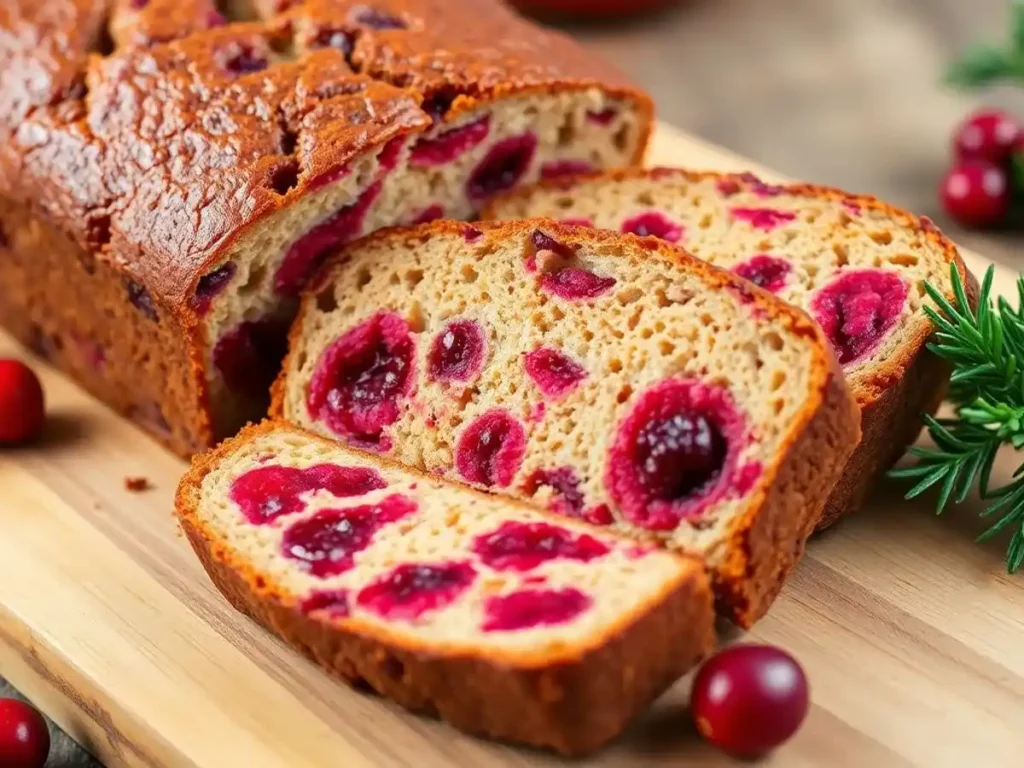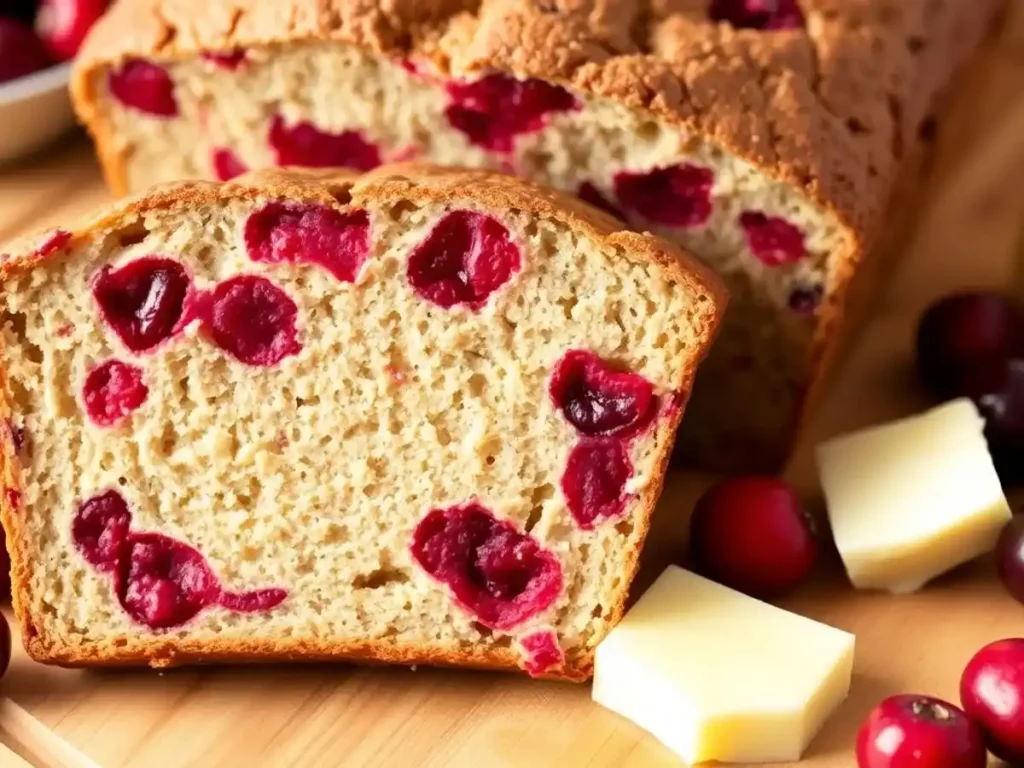Ever wondered if you should refrigerate cranberry bread? It’s a common question, especially if you’re new to baking this tasty treat. Cranberry bread is a favorite in many households, especially around the holidays. But how you store it can make a big difference in how long it stays fresh and delicious. Let’s dive into whether refrigeration is the best option for your cranberry bread or if there are better ways to keep it tasty.
Table of Contents
Key Takeaways
- Cranberry bread doesn’t necessarily need to be refrigerated; room temperature storage works for a few days.
- Wrapping the bread tightly in plastic wrap or foil helps maintain its freshness.
- Freezing cranberry bread is a great option if you want to keep it for a longer period.
- Using airtight containers can prevent the bread from drying out or absorbing other odors.
- Refrigeration might extend shelf life but could alter the bread’s texture.
Understanding If Cranberry Bread Be Refrigerated
What Is Cranberry Bread and Why Storage Matters?
Cranberry bread is a delightful type of quick bread that incorporates the tartness of cranberries, often balanced with a hint of sweetness. It’s a popular choice for breakfast or a snack, especially during the fall and winter months when cranberries are in season. Unlike yeast breads, cranberry bread is leavened using baking powder or baking soda, making it simple and quick to prepare.
For a detailed recipe on making the perfect cranberry bread, check out our guide on Learn How to Bake the Perfect Cranberry Bread.
Key Ingredients That Affect How Cranberry Bread Be Refrigerated
The main ingredients in cranberry bread include flour, sugar, baking powder, and salt, which form the base of the bread. Cranberries, either fresh or dried, are the star ingredient, providing a burst of flavor and color. Often, orange zest or juice is added to enhance the taste, creating a classic cranberry-orange combination. Other ingredients like nuts or spices can be included for additional texture and flavor.
The Popularity of Cranberry Bread
Cranberry bread’s popularity is partly due to its versatility and ease of preparation. It’s a staple in many households during the holiday season, often served at family gatherings or given as a homemade gift. Its sweet and tangy flavor makes it a favorite among both adults and children. Additionally, cranberry bread can be adapted to fit catering to a wide range of dietary preferences, including options suitable for gluten-free and vegan lifestyles, broadening its appeal.
The Importance of Proper Storage for Cranberry Bread

Why Storage Matters
Proper storage of cranberry bread is crucial to maintain its freshness and flavor. When stored incorrectly, the bread can become stale, dry, or even moldy. Ensuring that cranberry bread is kept in a suitable environment helps preserve its taste and texture for longer.
Common Storage Mistakes
Many people make simple mistakes when storing their cranberry bread. Here are a few to watch out for:
- Let me know if you’d like another variation.
- Storing it in a damp place, encouraging mold growth.
- Not using airtight containers, which can lead to flavor loss.
To learn about the science behind why cranberry bread sometimes changes color, read our article on Why Does Cranberry Bread Sometimes Turn Green?.
How Storage Affects Freshness
The way you store cranberry bread significantly impacts its freshness. If left out at room temperature, it might stay fresh for a couple of days. However, using airtight containers or wrapping it properly can extend its shelf life. For longer preservation, consider freezing the bread, which can keep it fresh for months. When you’re ready to eat, just thaw and enjoy as if it were freshly baked.
Should Cranberry Bread Be Refrigerated or Stored Differently?
Pros of Refrigerating Cranberry Bread
Refrigerating cranberry bread can be a smart choice if you want to extend its shelf life beyond a couple of days. Keeping it cold can help slow down the growth of mold and bacteria, which is especially useful if your home is warm or humid. Plus, if you’ve added perishable ingredients, like cream cheese or yogurt, it’s safer to store it in the fridge. Some folks also claim that chilling the bread enhances the flavors, making the tartness of the cranberries pop even more.
For advice on how to keep your cranberry bread soft and moist, explore our guide on Tips for Keeping Bread Soft and Moist.
Cons of Refrigerating Cranberry Bread
On the downside, refrigerating cranberry bread can dry it out. The cold air in the fridge tends to suck out moisture, leaving your bread less soft and more crumbly. If you’re planning to eat the bread within a couple of days, keeping it at room temperature might be a better option. Just wrap it tightly in plastic or store it in an airtight container to maintain its freshness. Also, some people feel that the texture changes when the bread is refrigerated, making it less enjoyable.
What Experts Say About Cranberry Bread Refrigeration
Experts often suggest that whether or not to refrigerate cranberry bread depends on how quickly you plan to eat it. If you’re going to finish it within two days, room temperature is usually fine. However, if you want it to last longer, refrigeration is recommended. The key is to wrap it well to prevent it from drying out. So, it really boils down to personal preference and how soon you’ll consume it. If you’re unsure, try both methods and see which one you prefer.
Alternative Storage Methods for Cranberry Bread
How Long Can Cranberry Bread Be Refrigerated?
Keeping cranberry bread at room temperature is a popular choice for many. To ensure maximum freshness, wrap the bread tightly in plastic wrap or place it in a resealable plastic bag. This method typically keeps the bread fresh for up to three days. It’s essential to store it in a cool, dry place, away from direct sunlight or heat, which can cause it to spoil faster.
Keeping Cranberry Bread Fresh at Room Temperature
Freezing is a fantastic way to extend the shelf life of your cranberry bread. First, let the bread cool completely. Then, wrap it tightly in plastic wrap or aluminum foil before placing it in a freezer bag. This method can keep the bread fresh for up to three months. When you’re ready to enjoy it, thaw the bread at room temperature, then warm it in the oven for a few minutes to restore its texture.
How Freezing Affects Cranberry Bread’s Freshness
Another effective storage method is using airtight containers. These containers help maintain the bread’s moisture and prevent it from drying out. Simply place the bread in the container and seal it tightly. This method is especially useful if you plan to consume the bread within a few days. For those who prefer a more eco-friendly option, consider using reusable silicone bags instead of plastic.
How to Maintain the Freshness of Cranberry Bread

Best Practices for Keeping Bread Fresh
Keeping cranberry bread fresh can be a bit of a juggling act, but it’s worth it to enjoy that tasty slice later. Always let your bread cool completely before wrapping it up. This prevents moisture from getting trapped inside, which can make it soggy. Once cooled, wrap it tightly in plastic or aluminum foil to keep air out. An airtight container works wonders too, especially if you’re storing it at room temperature. If you’re planning to enjoy it within a few days, room temperature storage is fine. But for longer storage, consider the fridge or even the freezer.
Signs Your Bread Has Gone Bad
It’s not always easy to tell when bread has gone bad, but there are a few telltale signs. Mold is the most obvious; if you see any, it’s time to toss it. A stale or off smell is another indicator. If the bread feels unusually hard or dry, it’s likely past its prime. Remember, it’s better to be safe than sorry when it comes to food safety.
Reviving Stale Cranberry Bread
Got some stale cranberry bread? Don’t worry, you can bring it back to life. Start by preheating your oven to 350°F (about 177°C). Wrap the bread in aluminum foil and pop it in the oven for about 10 minutes. This should soften it up nicely. For an extra touch, add a bit of butter or honey after warming. It’s a simple trick that can make your bread taste almost as good as new.
The Impact of Ingredients on Cranberry Bread Storage
Fresh vs. Dried Cranberries
When it comes to cranberry bread, the choice between fresh and dried cranberries can affect not just the flavor, but also how you store it. Fresh cranberries are juicy and can create moist pockets in the bread, which might lead to quicker spoilage if not stored properly. On the other hand, dried cranberries are less perishable and can help the bread last longer at room temperature. If you opt for dried cranberries, you might want to reduce the quantity to about a cup to keep the balance right.
The Role of Orange Zest
Orange zest is often used in cranberry bread to give it a zesty kick. While it adds a refreshing flavor, it also has a subtle impact on storage. The oils in the zest can keep the bread moist, but too much can make it soggy over time. So, if you’re planning to store your bread for a few days, consider using a moderate amount of zest.
How Sugar Content Affects Storage
Sugar acts as a natural preservative in baked goods. In cranberry bread, a higher sugar content can help extend its shelf life by retaining moisture and preventing it from drying out too quickly. However, too much sugar can make the bread overly sweet and sticky, which might not be ideal for everyone. Finding the right balance is key to maintaining both taste and freshness.
Serving Suggestions for Cranberry Bread

Pairing Cranberry Bread with Beverages
Cranberry bread is a delightful treat that pairs beautifully with a variety of beverages. A warm cup of coffee complements the tartness of cranberries, creating a harmonious balance of flavors. For a more festive option, consider serving it with spiced Russian tea or a cozy chai latte. These spiced drinks enhance the bread’s fruity notes, making for a comforting experience, especially during the colder months.
Creative Toppings for Cranberry Bread
Enhancing your cranberry bread with creative toppings can elevate its flavor profile. Consider spreading a thin layer of cream cheese or butter for a rich, creamy texture. For those who enjoy a bit of sweetness, a drizzle of honey or maple syrup can be delightful. You can also try topping it with a sprinkle of powdered sugar or a dollop of whipped cream for a touch of indulgence.
Cranberry Bread as a Holiday Treat
Cranberry bread is a fantastic holiday treat, offering a burst of festive flavor. Its vibrant red cranberries and aromatic orange zest make it a perfect addition to your holiday table. Whether served as a breakfast item or a dessert, it’s sure to impress guests. For a special touch, consider gifting a loaf to friends or family, wrapped in festive paper. This thoughtful gesture not only shares the deliciousness but also the joy of the season.
Looking for creative ideas on how to pair cranberry bread with other dishes? Check out our tips on Creative Ideas for Cranberry Bread Pairings.
Exploring Variations of Cranberry Bread
Cranberry Orange Bread
Cranberry Orange Bread is a delightful twist on the classic cranberry loaf, combining the tartness of cranberries with the refreshing zing of orange. This bread often features fresh or dried cranberries and incorporates orange zest and juice for that citrusy kick. Some recipes even top it off with a sweet orange glaze, adding an extra layer of flavor. If you’re a fan of this combo, you might also enjoy experimenting with lemon cranberry bread for a different citrusy experience.
Gluten-Free Cranberry Bread
For those with gluten sensitivities or preferences, gluten-free cranberry bread is a fantastic option. This version typically uses almond flour, coconut flour, or a gluten-free all-purpose mix. Despite the absence of traditional wheat flour, this bread remains moist and flavorful. It’s a great way to enjoy cranberry bread without compromising on taste or texture.
Vegan Cranberry Bread Options
Vegan cranberry bread is perfect for those following a plant-based diet. This variation skips the eggs and dairy, often using applesauce, mashed bananas, or flaxseed meal as a binding agent. Plant-based milk like almond or soy can replace cow’s milk, ensuring the bread stays moist and delicious. The result is a loaf that’s not only vegan but also packed with the rich flavors of cranberries. Whether you’re vegan or just exploring new recipes, this bread is a must-try.
Frequently Asked Questions About Cranberry Bread
Can You Substitute Ingredients?
Absolutely, you can substitute ingredients in cranberry bread recipes. If you’re out of fresh cranberries, dried ones work just fine. Just remember to use about a cup instead of the usual amount. This makes the bread slightly sweeter but still delicious. For those who want a twist, try swapping orange zest with lemon zest for a different citrusy kick.
How Long Does Cranberry Bread Last?
Cranberry bread usually stays fresh for about 3 days at room temperature. Make sure to wrap it tightly in plastic wrap or keep it in a resealable bag. If you want it to last longer, freezing is a great option. Just wrap it well and it can stay in the freezer for up to two months. When you’re ready to eat, let it thaw at room temperature.
Is Cranberry Bread Healthy?
Cranberry bread can be considered a healthier treat, especially if you’re using whole wheat flour and cutting back on sugar. Fresh cranberries are packed with antioxidants, which are great for your health. However, keep in mind that the sugar content can add up, especially if you’re adding a glaze or sweet toppings. Enjoy it in moderation as part of a balanced diet.
Final Thoughts: Should Cranberry Bread Be Refrigerated?
So, should you pop that cranberry bread in the fridge? Well, it really depends on how soon you plan to eat it. If you’re going to finish it within a couple of days, leaving it wrapped on the counter is just fine. But if you think it’ll take longer, or if you just like your bread a bit chilled, go ahead and refrigerate it. Just make sure it’s wrapped up tight to keep it fresh. And hey, if you want to save some for later, freezing is a great option too. Just thaw it out when you’re ready for a slice. Whatever you choose, enjoy every bite of that sweet and tangy goodness!
